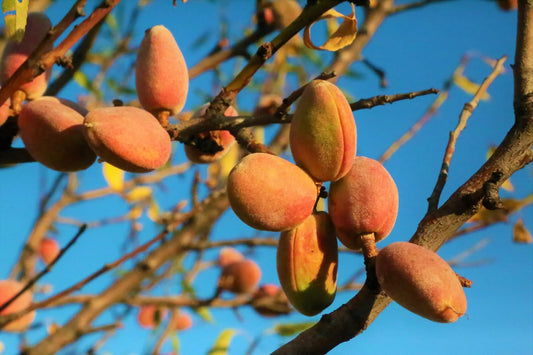-
Delivery from 10 plants to France, Switzerland and Europe
Delivery method -
Almond Tree Wholesale Supplier
About Us -
Quality Almond Tree Plants
Technical itineraries
Texas Almond Plants at Producer Prices for Professional Fruit Growers
The prices shown are our base prices for large volumes. Depending on the quantity ordered and the producers’ pricing scales, the rate may be adjusted upward. Each quote is personalized to ensure you receive a fair price.
Collapsible content
FAQ: Planting Tips
-
Texas Almond Plant Bare-root Stem Conventional
Regular price €21,00 EURRegular priceUnit price / per -
Texas Almond Plant Conventional Bare Root Cattail
Regular price €16,50 EURRegular priceUnit price / per -
Texas Almond Plant Conventional Bare-Root Scion
Regular price €11,50 EURRegular priceUnit price / per -
Organic Texas Almond Tree Scion Bare Root
Regular price €14,80 EURRegular priceUnit price / per -
Texas Almond Plant Half-Stem Diameter 8-10 cm Bare Root Conventional
Regular price €24,50 EURRegular priceUnit price / per -
Texas Almond Plant Half-Stem Diameter 6-8 cm Bare Root Conventional
Regular price €22,50 EURRegular priceUnit price / per -
Texas Almond Plant Half-Stem Diameter 10-12 cm Bare Root Conventional
Regular price €26,00 EURRegular priceUnit price / per
Collection: Texas Almond Plants at Producer Prices for Professional Fruit Growers
Texas Almond Variety Fact Sheet
- Fruit flesh color: Orange-yellow or white of excellent quality
- Fruit skin color: Brown
- Size and Shape: Approximately 5cm in diameter, elliptical, medium sized
- Tree size: 3 to 6 meters in height
- Fruit maturity: Harvest fresh almonds in July-August, and dry almonds in October or from September to October
- Fruit Taste: Sweet and delicate flavor with a slight hint of bitterness, balanced and slightly sweet. Crisp texture.
- Earliness of the variety: Late
- Fruiting period: October
- Disease resistance and storage: Fairly resistant to fungal diseases. Good storage if stored in a cool, dry place.
- Variety yield: High and abundant productivity from a young age
- Is this variety self-fertile? Not self-fertile, requires a pollinator. Varieties like Ferragnes or Princess are recommended. Partially self-fertile, but the presence of another almond tree nearby is recommended to maximize production.
- Commercial use: Direct consumption, processing into almond oils and milks, baking.
- Is this a COV variety? No
- Comments: Hardy to -15°C, but may require winter protection in colder climates. Prefers well-drained, stony, calcareous soils. Sensitive to moisture-retaining clay soils. American variety (Texas, 1891).
Quick Read / Essentials on the Texas Almond Tree
The Texas almond tree is a variety native to the United States, renowned for its high productivity and the exceptional quality of its almonds. Its balanced taste, with a slight hint of bitterness, makes it a sought-after product in baking and for the production of almond oils and milks. This vigorous tree adapts perfectly to dry and hot climates, making it a preferred choice for French producers operating in the Mediterranean region. If you are looking to buy Texas almond plants , Amandiverse , your specialist wholesale supplier of almond plants , offers you rigorously selected plants to guarantee optimal yield and successful cultivation.
Texas almonds are medium-sized, encased in a hard, brown shell. They are distinguished by their crisp texture and subtly sweet flavor, making them ideal for direct or processed consumption. Thanks to their natural resistance to arid conditions and excellent longevity—sometimes exceeding a century—this almond tree is a profitable and sustainable investment for tree growers.
The Texas almond tree blooms early but matures late, with dry almonds harvested in October. It is partially self-fertile, but to maximize production, it is recommended to combine it with compatible pollinators such as Ferragnes or Princesse. In terms of growing conditions, this variety tolerates calcareous and stony soils well, but is very susceptible to root asphyxiation. Therefore, it is essential to favor well-drained soil and a suitable rootstock to ensure optimal growth.
If you want to buy Texas almond plants , trust Amandiverse , your specialist wholesale supplier of almond plants . We select the best varieties to meet the requirements of professional growers and guarantee a successful and sustainable plantation.
Introducing the Texas Almond Tree
The Texas almond tree is a variety of American origin, obtained in 1891. It is distinguished by its high productivity , its vigor and the quality of its almonds, which offer a balanced and slightly sweet flavor with a slight touch of bitterness. It is particularly suited to dry and hot climates, making it an excellent choice for French almond growers operating in Mediterranean or low rainfall regions.
Fruit characteristics
Texas almonds are characterized by a yellow-orange flesh , sometimes described as white, with a firm, juicy and aromatic texture. They are medium-sized , with a diameter of about 5 cm , and a hard brown shell. Their elliptical shape and crunchy texture make them a sought-after product for direct consumption or processing.
Their taste is remarkable, with a natural sweetness and a slight bitterness reminiscent of the finest almond varieties. This balanced flavor makes them ideal for use in baking, confectionery, as well as for the production of almond oils and milks.
In terms of conservation , Texas almonds are easily stored in a cool, dry place, allowing consumption over several months without altering their organoleptic qualities.
Tree characteristics
The Texas almond tree reaches a mature height of between 3 and 6 meters . It is known for its strong vigor and upright habit , which facilitates shaping and crop management. Thanks to this natural architecture, it does not require staking , except in cases of exposure to strong winds.
This tree is distinguished by its exceptional longevity , which can exceed a century , which makes it a sustainable investment for producers.
Vegetative and flowering cycle
The Texas almond tree is a late-ripening variety , although it blooms early . This makes it susceptible to spring frosts , which can impact its production if weather conditions are unfavorable.
Fruiting occurs in October , a relatively late period compared to other varieties. Fresh almonds are harvested in July-August , while dried almonds are available from October .
Pollination and varietal compatibility
This variety is partially self-fertile , but to maximize yield, it is recommended to plant compatible pollinators nearby. Varieties such as Ferragnes or Princesse are particularly suitable for ensuring good pollination and optimizing fruit set.
Resistance to diseases and climatic conditions
The Texas almond tree has good resistance to fungal diseases , which limits the need for phytosanitary treatments. However, like all almond trees, it can be subject to attacks by aphids and mealybugs , requiring monitoring and preventive measures.
It is very resistant to summer drought , making it an ideal option for areas with low rainfall. On the other hand, it is very sensitive to root asphyxiation , which implies careful choice of soil type and drainage .
Adaptation to soil and rootstocks
The Texas almond tree thrives in calcareous soils and can adapt to stony or sandy-loam soils, provided they are well-drained. Its intolerance to stagnant water means heavy, compacted soils should be avoided.
In France, it is commonly grafted onto Prunus persica or other compatible rootstocks , which promote its development while improving its tolerance to water stress and local growing conditions.
Economic yield and interest
The Texas almond tree is known for its high productivity , producing quality almonds from a young age. Although accurate data on average yield is limited, it is estimated that a tree can produce approximately 10 kg of unshelled almonds per season.
Thanks to its excellent taste quality, its almonds are sought after for various commercial applications. They are used for direct consumption, in agri-food processing (oils, almond milks) as well as in pastries and confectionery . Their ability to be consumed fresh in July or dried in October makes it a versatile variety for the market.
Recommendations for cultivation
To optimize Texas almond production, several elements must be taken into account:
- Pollination : This variety requires a pollinator, it is imperative to associate other compatible varieties such as Ferragnes or Princesse in order to guarantee a good yield.
- Soil drainage : Due to its sensitivity to root asphyxiation , it is essential to choose a light, stony or sandy-loam soil, ensuring effective drainage and avoiding any water retention.
- Exposure : Maximum sunlight is required to ensure optimal growth and abundant production. It is also advisable to plant the tree in an area sheltered from cold winds .
- Protection against late frosts : Its early flowering can be affected by spring frosts, hence the need to opt for protection methods in the event of risky climatic conditions (winter veils, choice of a less exposed area).
Prospects for improvement and areas for vigilance
The Texas almond tree is an excellent option for growers looking to combine high yields with good taste . However, it would be worthwhile to examine the optimal pruning techniques for this variety, in order to maintain a balanced structure and promote fruiting.
Particular attention must also be paid to water management , due to its sensitivity to excess moisture. By incorporating these good cultural practices, the Texas almond tree will be able to offer abundant and sustainable production, guaranteeing an excellent return on investment for professional almond growers.
To summarize: Texas Almond
The Texas almond tree is an ideal choice for growers looking for a high-yielding tree with superior flavor. Its ability to tolerate summer drought makes it a popular variety for low-rainfall regions. With an average production of 10 kg of almonds per tree per season, it represents an excellent economic opportunity for farmers looking to diversify their production.
One of the main advantages of this variety is its versatility: its almonds can be eaten fresh as early as July or dried from October. They are particularly appreciated for processing into almond milk and oil, as well as for confectionery and baking. However, the sensitivity of the Texas almond tree to spring frosts requires special attention to the selection of the planting site and the adoption of appropriate protection.
For successful cultivation, several recommendations must be followed:
- Pollination : Combine the Texas almond tree with pollinating varieties such as Ferragnes or Princesse to ensure optimal fruit set.
- Soil and drainage : Favor light, well-drained soils to avoid root asphyxiation, to which this variety is particularly sensitive.
- Exposure : Maximum sunshine is necessary to ensure good flowering and abundant fruiting.
- Protection against late frosts : Avoid areas prone to spring frosts or use protective techniques such as wintering veils.
If you are a professional looking to buy Texas Almond plants , Amandiverse , your specialist wholesale supplier of almond plants , offers you quality plants, selected for their robustness and their adaptation to growing conditions. Our experts are at your service to assist you in your project and advise you on the best planting and maintenance practices.
Whether you are an experienced arborist or a producer looking to diversify, trust Amandiverse , your specialist wholesale supplier of almond plants , to provide you with high-performance plants adapted to your needs. Contact us today to learn more about our professional planting solutions!

